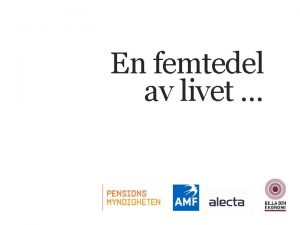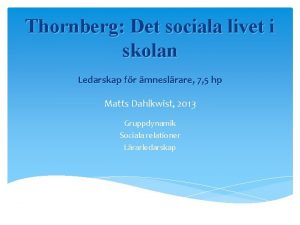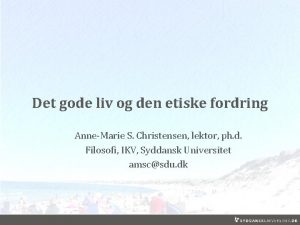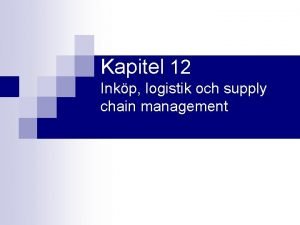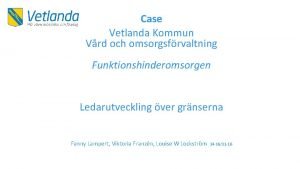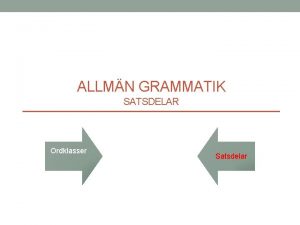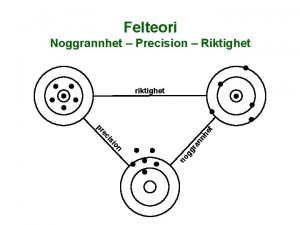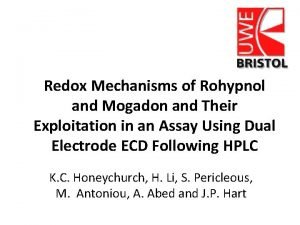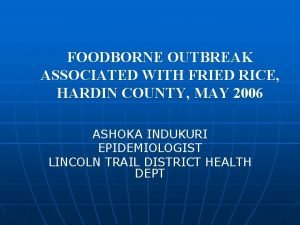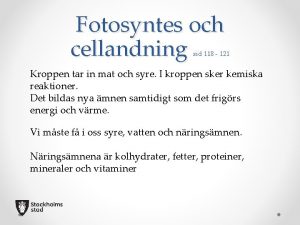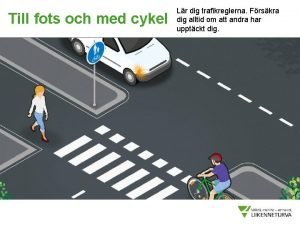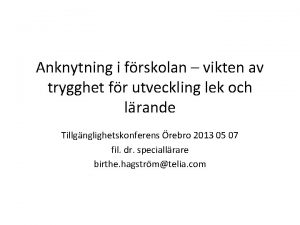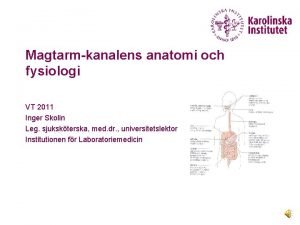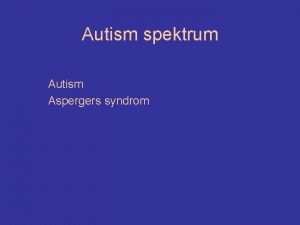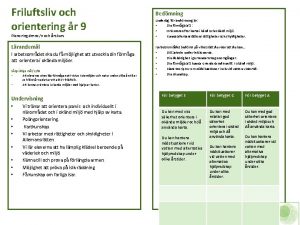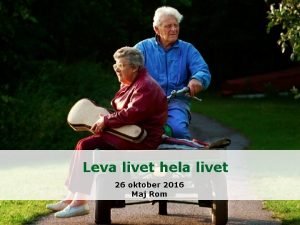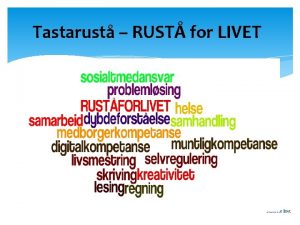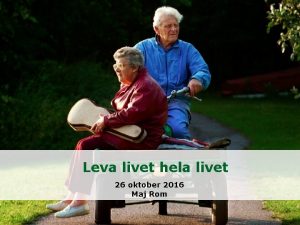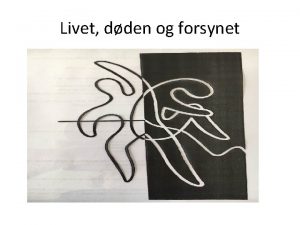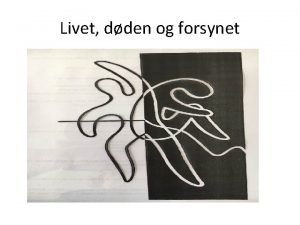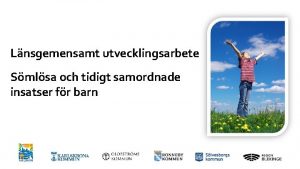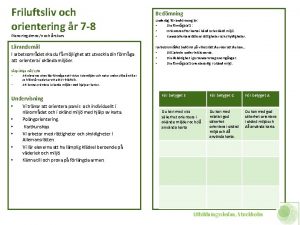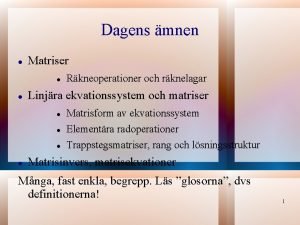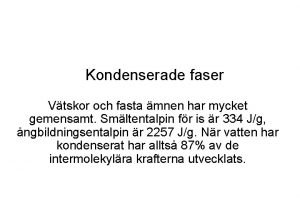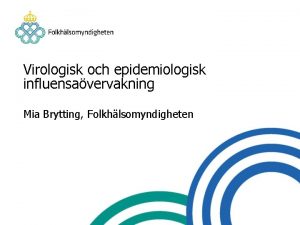Exponering fr hormonstrande mnen tidigt i livet och










































- Slides: 42

Exponering för hormonstörande ämnen tidigt i livet och betydelsen för barns utveckling och hälsa Carl-Gustaf Bornehag Professor in Public Health Sciences Karlstad University Sweden

Content • Vad är ett hormonstörande ämne? – Endocrine Disrupting Chemical (EDC) • Varför oroa sig för EDCs? – Concern • Problem med nuvarande riskvärdering? – Paracelsus dos-responsparadigm • Speciella problem vid riskvärdering – – Utbyte av molekyler i varor och produkter Könsskillnader Samsjuklighet Exponeringar för blandningar

The Great Lake District ake Monona, Madison, Wisconsin, US

Theo Colborn 1907 -1964 1927 -2014 1994

Our natural hormones are of the greatest importance for a healthy development during the entire life span from the moment of conception until death

Endocrine Disrupting Chemicals (EDCs) -Natural estrogen hormone Binding Adverse health effect

The dirty dozen The 12 worst endocrine disrupters (EWG) Bisphenol-A (BPA) Dioxin Atrazine Phthalates Perchlorate Fire retardants Lead Mercury Arsenic Perfluorinated chemicals (PFCs) Organophosphates Glycol ethers

Pharmaceutical drugs Metals Natural occuring hormones Building materials Endocrine Disrupting Chemicals Pesticides Herbicides Fungicides Food Water Personal care products Consumer products

Early life is important David Barker (1938 -2013) The fetal period is important for chronic diseases later on in life, e. g. , hypertonia, diabetes, cardiovascular diseases. . .

Birth weight

Low birth weight Body weight Macrosomia IUGR*** Median IUGR Birth Wean Adult

Low birth weight & Centile crossing Body weight Macrosomia IUGR*** Median IUGR Birth Wean Adult

e s a e s i d t l u d a f o s i s a ntal b e m p o l e v e d e Th Stress Infections Malnutrition Pharmaceuticals Environmental chemicals Environmental influences during development A 70 year old man with cardiovascular disease A 60 year old man with Parkinson's disease A 50 year old women with breast cancer A 40 year old man with type 2 diabetes A 30 year man with infertility problem A LM A 20 year old man with overweight A 10 year old boy with asthma A 6 year old boy with ADHD A newborn boy with malformed genitals SE

And remember that three generations are exposed………. .

The low dose controversy exemplified by bisphenol A

The low dose controversy exemplified by bisphenol A Myer et al. , 2008

Response The dose-response paradigm Phillippus Aureolus Theophrastus Bombastus von Hohenheim Paracelsus 1493 -1541 Dose

Response Non-monotonic dose responses Toxicity Programming Dose

Regulatory science Response MTD 1493 -1541 LOAEL NOAEL Safe dose Safety factors Dose

EDCs are not poisons!

Replacement of phthalates in PVC DINCH ? Non-phthalate Di. NP DEHP 1990 2000 2015

Replacement of phthalates in PVC ? DINCH Non-phthalate Greenscreen 2012 Campioli et al. , 2015 Di. NP Lee et al. , 2001 Lee et al. , 2006 Borch et al. , 2004 DEHP Clevell et al. , 2013 Boberg et al. , 2011 Hannas et al. , 2011 Bornehag et al. , 2015 Axelsson et al. , 2015 Foster et al. , 2005 # studies Swan et al. , 2005 Gray et al. , 2000 1990 2000 Swan et al. , 2015 Bustamente al. , 2013 Suzuki et al. , 2012 2010 2015


N=2, 356 (2008 -2010) Conception Birth 1 y 2 y 3 y 4 y 5 y 6 y N=1, 500 (2015 -2016) 7 y N=1, 951 “Exposure” data EDC exposure* Thyroid Analyzed & serum hormones in biomarkers Vitamin D cord blood** Serum/Urine Child (n=1, 516) Biobanked Mother samples (n=2, 356) Questionnaires Q 1 Data from public child health care Q 2 Q 3 X X Urine Child (n=+900) Q 4 Q 5 X X Reproduction and sexual development Urine/Blood Child AGD Puberty onset Play behavior AGD (n=196) Cognitive outcomes Speech and language Motor outcomes Executive functions & behavior Language screening (n=1, 150) Asthma and allergy X X X Metabolic outcomes Birth Weight (n=1, 645) X X X Epigenetic (Exosomes, placenta related mi. RNA, etc. ) Prenatal Serum Cord blood Q 8 X X Neurodevelopment and behavior Health outcomes Q 7 Q 6 X Eczema Asthma Rhinitis Ig. E Inflammation markers Growth since birth BMI Full blood Urine Etc.

Group Phthalates (urine) Parent compound Metabolite n>LOD GM (95% CI) (ng/m. L) 95% (ng/m. L) DEP MEP 2, 356 67. 97 (60. 30 - 76. 60) 511. 49 DBP MBP 2, 356 63. 99 (57. 72 - 70. 94) 236. 03 BBz. P MBz. P 2, 356 16. 11 (14. 17 - 18. 32) 101. 59 MEHP MEHHP MEOHP MECCP 7 OH-MMe. OP 7 OXO-MMe. OP 7 CX-MMe. OP BPA Triclosan PFNA PFDA PFUn. DA PFDo. DA PFHx. S PFHp. A PFOS 2, 356 2, 356 2, 167 2, 393 2, 381 1, 083 2, 393 1, 748 2, 393 3. 28 (2. 98 - 3. 61) 14. 49 (13. 23 - 15. 87) 9. 73 (8. 86 - 10. 68) 14. 25 (13. 03 - 15. 58) 6. 82 (6. 14 - 7. 58) 3. 06 (2. 81 - 3. 34) 10. 84 (10. 00 - 11. 75) 17. 30 67. 57 46. 33 65. 30 60. 18 20. 92 78. 31 6. 37 315. 41 1. 33 0. 60 0. 53 0. 08 3. 66 0. 10 3. 96 12. 00 DEHP Di. NP Phenols (urine) Phenols Per- and polyfluorinated alkyl substances (serum) PFASs 1. 54 (1. 48 - 1. 91) 0. 75 (0. 61 - 1. 18) 0. 54 (0. 53 -0. 55) 0. 26 (0. 25 -0. 27) 0. 21 (0. 20 -0. 22) 0. 05 (0. 04 -0. 06) 1. 31 (1. 30 -1. 32) 0. 03 (0. 01 -0. 04) 1. 61 (1. 60 -1. 62) 5. 24 (5. 23 -5. 25)

Sexual dimorphism

Natural hormones Estrogen Testosterone Thyroids. etc. EDCs PFAS Met a m s i l o b a h t w o nd gr


Association btw prenatal (week 10) PFAS exposure and birth weight in 1, 128 children Compound Beta (95% CI)* P-value PFOA -242 (-367, -116) <0. 001 PFNA -169 (-296, -43) 0. 008 PFDA -161 (-300, -22) 0. 023 PFOS -124 (-246, -2) 0. 046 PFUn. DA -68 (-184, 48) 0. 248 PFDo. DA -56 (-134, 22) 0. 163 PFHx. S -34 (-142, 74) 0. 536 PFHp. A -2 (-66, 62) 0. 954 *) Adjusted for sex, mothers smoking (serum cotinine; <0. 2 ng/m. L; 0. 2 -15 ng/m. L; >15 ng/m. L), maternal weight, parity, gestational length, diet (fish consumption).

Prenatal PFOA and PFOS exposure and birth weight stratified for sex Boys 1 st vs. 4 th; p=0. 003 Girls 1 st vs. 4 th; p<0. 001 Boys 1 st vs. 4 th; p=0. 059 Girls 1 st vs. 4 th; p<0. 001

Prenatal PFAS exposure and metabolism/growth SELMA Body weight Macrosomia IUGR*** Median IUGR Birth Wean Adult


Natural hormones Estrogen Testosterone Thyroids. etc. EDCs “Xenoestrogens” Anti-androgens Phthalates l a u x e S t n e m p o l e v de y t i l i t r & fe

1 st trimester Di. NP exposure increase the risk for shorter AGDas in 196 SELMA boys (21 m) OR (95% CI) 10 1 Bornehag et al. , 2015 0. 1 1 st ref 2 nd MEP 3 rd MEP 4 th 1 st ref 2 nd MBP 3 rd MBP 4 th 1 st ref 2 nd 3 rd MBz. P 4 th 1 st ref 2 nd 3 rd DEHPsum Di. NPsum Phthalate metabolites in quartiles 4 th

Natural hormones Estrogen Testosterone Thyroids. etc. EDCs “Xenoestrogens” Anti-androgens Phthalates t n e m p o l e v de o r u e N Language Delay! Unenge Hallerbäck et al. , in manuscript

Language screening at 2. 5 y Parental reports Number of words (10%) Use of sentences Understand sentences Dribbling Parents worry Nurses evaluation Spontaneous speech Two word sentences Follow short instructions Eye contact Referred to; -speech therapist (3%) -psychologist -pediatrician

Steroid hormones (Testosteron) Sexual development Fetal programming ? Anti-androgen EDCs (Phthalates) Neurodevelopment ge a u g Lan elay d

Language delay at 30 m and anogenital distance at 21 m in 149 boys in SELMA p=0. 069 Over 50 words n=129 AGDas Less than 50 words n=20

EDC-Mix. Risk Integrating Epidemiology and Experimental Biology to Improve Risk Assessment of Exposure to Mixtures of Endocrine Disruptive Compounds

Hannu Kiviranta National Institute for Health and Welfare Helsinki, FI • Karolinska Institute • Karlstad University • Gothenburg University • Lund University • Stockholm University • Uppsala University Barbara Demeneix Muséum National d’Histoire Naturelle Paris, FR Chris Gennings Mount Sinai School of Medicine New York, USA Wieland Kiess University Hospital Leipzig, GE Giuseppe Testa The European Inst. Of Oncology Milan, IT Efthymia Kitraki University of Athens, GR

Summary • Some chemicals may interact with the natural endocrine system in humans and animals • Concerns are low dose exposure, delayed effects, multiple sources, multiple health outcomes • Current risk assessment doesn´t include programming effects • Specific problems related to risk assessment – Replacement of molecules in products – Sexual dimorphism – Comorbidity – Exposure for mixtures of EDCs

Thank you! Vandenberg et al. , 2013, Reproductive Toxicology Regulatory decision and research on EDCs have to be based on principles of endocrinology!
 Lena holzman
Lena holzman Tjock och smal liten och stor
Tjock och smal liten och stor Jämförelse hinduism och buddhism
Jämförelse hinduism och buddhism Livet er en morgengave tekst
Livet er en morgengave tekst Leva livet fullt ut
Leva livet fullt ut Balans i livet övning
Balans i livet övning Gruppsocialisation
Gruppsocialisation Ringelmanneffekten
Ringelmanneffekten Aristoteles meningen med livet
Aristoteles meningen med livet Noget om helte tekst højskolesangbogen
Noget om helte tekst højskolesangbogen Livskompassen act
Livskompassen act Smärtskolan kunskap för livet
Smärtskolan kunskap för livet De evige tre symboler
De evige tre symboler Judarnas huvudbonad
Judarnas huvudbonad Leve hele livet konferanse
Leve hele livet konferanse Funktionsorganisation och produktorganisation
Funktionsorganisation och produktorganisation Buklash
Buklash Leverantörsbedömning och leverantörsutvärdering
Leverantörsbedömning och leverantörsutvärdering Vetlanda kommun vård och omsorg
Vetlanda kommun vård och omsorg Bisats och huvudsats
Bisats och huvudsats Biologisk nisch
Biologisk nisch Morotssoppa barn diarre
Morotssoppa barn diarre Pronomen och domstol
Pronomen och domstol Formtolerans
Formtolerans Ledarskapsteorier
Ledarskapsteorier Styra och reglera
Styra och reglera Franz josef och
Franz josef och Rohypnol mogadon
Rohypnol mogadon Datastrukturer och algoritmer liu
Datastrukturer och algoritmer liu Vad är skillnaden mellan reklam och information
Vad är skillnaden mellan reklam och information Rice och hardin
Rice och hardin Leda och planera
Leda och planera Beskriv cellandningen
Beskriv cellandningen Till fots och med cykel
Till fots och med cykel Anknytning och trygghet i förskolan
Anknytning och trygghet i förskolan Strsta
Strsta Exempel på kronolekt
Exempel på kronolekt Leverantörsbedömning och leverantörsutvärdering
Leverantörsbedömning och leverantörsutvärdering Bakre och främre regionen
Bakre och främre regionen Skillnaden mellan kemisk förening och blandning
Skillnaden mellan kemisk förening och blandning Enterogastriska reflexen
Enterogastriska reflexen Iq spektrum
Iq spektrum Tuman deb nimaga aytiladi
Tuman deb nimaga aytiladi



